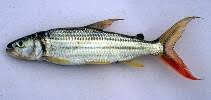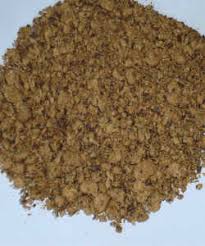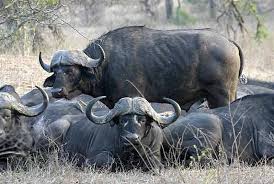|
Research Title /
Graphical Abstract
|
Article Information /
Abstract
|
Download
|
|
Effect of different salt concentration on total Bacterial count and heavy metal Composition of the Fish Hydrocynus spp.

|
Original Research, C17
pii: S222877011300017-3
Abbas Bakhiet H.H. and Khogalie F.A.E.
Online J. Anim. Feed Res., 3(2): 87-90, 2013.
ABSTRACT: This piece of work was done in an attempt to evaluate the issue of the traditional fish salting practice in the Sudan. Fassiekh was selected as one of the widely consumed salted fish product, of great preference among Sudanese consumers. The study was directed towards the study of the heavy metal concentration and the microbiological analysis of fresh fish and fassiekh to compare the effect of the different salt concentrations. One kind of fish species preferable by Sudanese consumers in fasseikh making was selected for this study namely hydrocynus spp (kass). Samples were taken from Elmawrada fish market, and subjected to three salt concentration levels (15%, 20%and 25%) by weight to achieve the goals of the study. Fresh fish were carefully handled throughout the preparation process; they were eviscerated and cleaned up and divided in to two groups then three sup groups to be treated with different salt concentration. After the fermentation process sample were taken to do the heavy metal concentration analysis and microbiological analysis. It was observed that the heavy metal (Arsenic, Cadmium and lead) concentration were not significant. But the microbiological analysis result showed significant decrease in total bacterial count in all concentrations.
Key words: Heavy Metal, Bacteria, Fish, Salt.
|
.
 . .
.

.
|
|
Effect of dietary raw chickpea (Cicer arietinum L.) seeds replacement groundnut meal, sesame meal on broiler performance and blood constituents

  |
Original Research, C18
pii: S222877011300018-3
Algam T.A., Abdel Atti Kh.A., Dousa B.M., Elawad S.M. and Atta Elmanan B.A.
Online J. Anim. Feed Res., 3(2): 91-95, 2013
ABSTRACT: This study was conducted to investigate the effect of chickpea seeds on performance and blood constituents of broilers. One hundred and twenty eight unsexed one day old (Ross) broiler chicks were randomly assigned to Four approximately isocaloric and isonitrogenous diets labeled as follows: Diet (F0) containing 0% chickpea (control diet), diet (F1) 10% chickpea substitute same levels of sesame meal and groundnuts meal, diet (F2) 10% chickpea substitute from groundnuts meal only and diet (F3) 10% chickpea substitute from sesame meal only. Each treatment had four replicates with 8 birds/replicate. The study lasted for 8 weeks. Parameters Measured were feed intake, body weight gain, feed conversion ratio (FCR), pre–slaughter weight, dressing percentage, protein efficiency, some blood parameters (glucose, cholesterol, triglyceride, total protein, calcium, and phosphorus) and profitability. The results showed significant decrease (P<0.05) in feed intake) for birds consumed the diets supplemented with chickpeas than control. Body weight gain, pre slaughter weight and carcass weight were significantly (P<0.05) greater for birds received diet F0 (1527.37g), (1615.49g), (1195.32g) respectively and diet F3 (1430.80g), (1472.29g), (1072.06g) respectively and lower for birds received diet F2 (937.71g), (761.58g) and (533.29g) respectively. No significant differences were observed in feed conversion ratio and protein efficiency ratio among all dietary treatments. Broiler chicks received diet F2 recorded significantly (P<0.05) poorer dressing percentage than other treated diets. All the treatments had no significant (P>0.05) effect on serum glucose, cholesterol, triglyceride, total protein, calcium and inorganic phosphorus levels. Broiler chicks received diet F3 recorded the highest profitability than other groups.
Key words: Chickpeas, Broilers; Performance; Carcass; Characteristics
|
.
 . .
.

.
.
.
|
The potential of rabbit meat marketing in Tizi-Ouzou area, Algeria


|
Original Research, C19
pii: S222877011300019-3
Kadi S.A., Djellal F., Berchiche M.
Online J. Anim. Feed Res., 3(2): 96-100, 2013.
ABSTRACT: In Algeria, the raising of the rabbit for meat develops more and more these last years. Several segments of this young sector have been studied as the feeding and reproduction. However, the segment of marketing has not been approached yet. This paper provides an overview of the rabbit meat marketing system in the Tizi-Ouzou area. To meet this objective the descriptive survey method was employed, using a structured questionnaire to provide data on commercialization of rabbit meat. Butcheries (n=192 ), poulterers (n=49 ), restaurants (n=184 ) and hotels (n=11 ) were concerned. Rabbit meat is sold in 8.48% (n=37) of stores visited and do not sold in 91.51% (n=399) ones. It’s marketed more cooked (restaurants and hotels) than fresh (butcheries and poulterers). 75.44% of respondents who do not sell rabbit meat justifies it by the lack of demand and 10.78% (n=43) because of its unavailability. Rabbits are bought from producers generally as whole carcasses (86.49%) of about 1.4 kg. In the butcheries and poulterers, rabbit meat is sold to consumers at an average price of 470 DA (1U$=95 DA). 44.56 kg of rabbit meat are sold per week. The marketing of this meat is fragmented, inefficient so its distribution chain is disorganized. Despite those problems, there are also opportunities for expansion of this market. Given the current low levels of consumption of rabbit meat, there is a potential for total consumption of this meat to increase substantially as production and availability increases. More attention must be given to the market outlets and promotions of rabbit meat in Tizi-Ouzou area.
Key words: Rabbit meat, Marketing, Tizi-Ouzou
|
 . .
.

.
.
|
|
Nutrient utilization in buffalo bulls fed crop residue based rations

|
Original Research, C20
pii: S222877011300020-3
Venkateswarlu S., Srinivas Kumar D. and Narendranath D.
Online J. Anim. Feed Res., 3(2): 101-105, 2013.
ABSTRACT: In 4 x 4 LSD, four graded Murrah buffalo bulls (6 yrs; 353 ± 8.26 kg) were fed four iso-nitrogenous complete rations comprising of jowar stover (CR1), maize stover (CR2), red gram straw (CR3) and black gram straw (CR4) as roughage source and concentrate mixture in 60:40 proportion, to study the effect of feeding complete rations on nutrient utilization. The DM intake (kg/d) was similar in all the groups. The digestibility coefficients of DM, OM, CP, EE, CF, NDF, ADF, Cellulose and Hemi-cellulose were significantly (P<0.01) higher in buffalo bulls fed CR2 while NFE digestibility was higher (P<0.05) in CR3 when compared to those fed other complete rations. All the animals were in positive N, Ca and P balances. Further, the % DCP and % TDN were significantly higher (P<0.01) in buffalo bulls fed CR2. It could be concluded that maize stover compared to other crop residues could be a superior roughage source for inclusion in complete rations for feeding buffalo bulls.
Key words: Black Gram Straw, Buffalo Bulls, Complete Rations, Jowar Stover, Maize Stover, Nutrient Utilization, Red Gram Straw.
|
.

.

.
|
|
Features topography and macrostructure lymph nodes of Camels (Camelus dromedarius)

|
Original Research, C21
pii: S222877011300021-3
Gavrylin P, Rahmoun DE, Lieshchova M, Benchadi H.
Online J. Anim. Feed Res., 3(2): 106-110, 2013.
ABSTRACT: This study was conducted to investigate the special features of topography and macrostructure of some somatic and visceral lymph nodes of the dromedary (Camelus dromedarius). The result of the study demonstrated that the arrangement and the morphometric characteristics of some lymph nodes of camel correspond to the analogical indices of cattle. At the organ level, the lymph nodes of camel congregate; they are partially fused. A pattern of spatial orientation of these nodes is not established. Lymph nodes of dromedary (Camelus dromedarius) according to their topography and linear characteristics in general correspond to the similar nodes of cattle. The architecture of the lymph node dromedary (Camelus dromedarius) differs from that shown in the conventional patterns of other mammalian animals, generally formed of a plurality of aggregates, the latter are surrounded by a connective tissue which extends over the whole area surface lymph node and each cluster is a node itself. Vascular distribution in these lymphoid aggregates is relatively abundant and each node receives one or two afferent lymphatic’s and is drained by four or five efferent lymphatic’s. In approximately half of nodes examined, there was extra nodal communications between the lymphatic vessels (afferent and efferent), allowing to bypass the lymph node. Lymph nodes are characterized by their dromedary lobule appearance and size.
Key words: Lymph Nodes, Dromedary, Topography, Macrostructure
|


.
|
|
Heamatological and serum biochemical characteristics of cockerels fed graded levels of boiled sorrel seed meal

|
Original Research, C22
pii: S222877011300022-3
Duwa H., Sale B. and Adegbolah T.A.
Online J. Anim. Feed Res., 3(2): 111-115, 2013.
ABSTRACT: The effect of feeding graded levels of boiled sorrel seed meal (BSSM) at 0,15,30,45 and 60% as replacement for groundnut cake in the diet of 200 seven day old chicks of Isa brown x Goldline cockerel on heamatological and serum biochemical indices was assessed in a 14week feeding trial. Each treatment consisted of forty birds and was replicated four times with 10 birds per replicate in a completely randomized design. At the end of the experiment, blood samples were randomly collected from four birds in each group for heamatological and blood chemistry studies. BSSM at 60% significantly (P<0.05) increased the values of RBC, Hb, WBC, PCV and MCV although they were within normal ranges. Total protein and albumin were significantly (P<0.05) increased while creatinine was significantly (P<0.05) reduced by higher levels of BSSM in the diet. It was concluded that up to 60% of GNC can be replaced by BSSM in the diet of cockerels without adverse effects on blood characteristics.
Key words: Cockerels, Boiled Sorrel Seed Meal, Heamatology, Serum Biochemistry
|


.
|
|
The nutritional composition and acceptability of cacti (Opuntia ficus indica)-legume mixed silage

|
Original Research, C23
pii: S222877011300023-3
Gusha J., Katsande S., Zvinorova P.I. and Ncube S.
Online J. Anim. Feed Res., 3(2): 116-120, 2013.
ABSTRACT: The potential of making silage using dry browse legume hay (Acacia angustissima, Leucaena leucocephala, Calliandra callothrysus and Macroptilium Atropurpureum) mixed with fresh cactus (Opuntia ficus-indica) for winter supplementation of veld grass was evaluated using the proximate, tannins and the pH analyses. Chemical analysis revealed that N values were significantly increased (P<0.05). The N levels were 3.72, 4.5, 4.05, and 2.5% DM for A. angustissima, L. leucocephala, C. callothrysus and M. atropurpureum respectively, which were higher when compared to silage made from cereals. The NDF and ADF values were slightly higher than those reported in literature for cereal silages. The DM level of cactus –browse silage was very good (41%DM) considering that cactus normally have less than 10% DM. The silage pH was within the reported range, ranging from 3.97 to 4.11 on a pH meter. This was a good indicator of silage quality considering that low pH inhibit undesirable microbial activities. The tannins levels were lower in the silages but significantly different (P<0.05) between browse legume species. Ensiling lowered the tannin levels in the silage compared to the individual browse legume tannin levels. This study concluded that purely on compositional laboratory analysis, the legumes and cactus can be used to make silage which can be used by farmers during dry season.
Key words: Opuntia ficus indica, Silage, Browse Legumes, Tannins, pH, Nitrogen
|

 |
|
|
|
|
|
|

